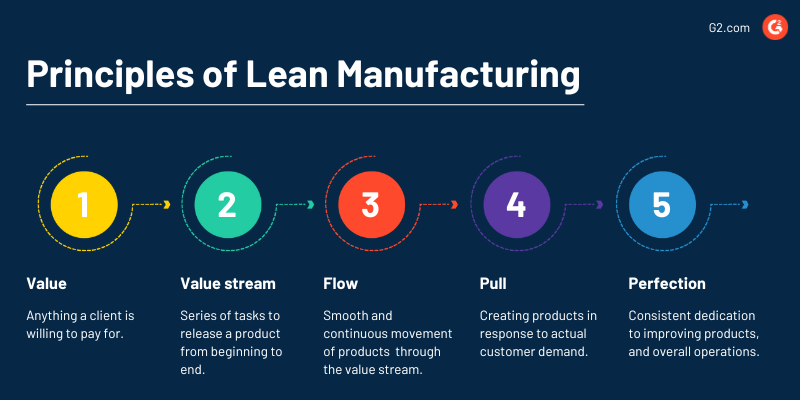What is lean manufacturing?
Lean manufacturing, sometimes known simply as "lean", is a production philosophy and strategy focused on increasing customer value while eliminating waste. It entails carefully identifying and removing non-value-added tasks and processes to simplify operations, gain efficiency, and elevate overall quality. The ultimate objective of the lean methodology is to provide high-quality products or services to consumers using as few resources, time, and waste as possible.
Having evolved from the Toyota Production System (TPS), lean manufacturing is built on five basic principles: defining customer value, mapping the value chain, developing pull-based manufacturing, and striving for perfection. Users can evaluate success with manufacturing execution systems (MES).
Lean production strives to increase production efficiency and drive continuous improvement by removing non-value-added activities and simplifying processes. It’s a comprehensive perspective implemented across many sectors to enhance operations and provide more value to consumers.
5 principles of lean manufacturing
Lean manufacturing's central principles have been created systematically to improve operations and eliminate waste. These ideas operate in tandem to form a foundation for efficient and customer-focused manufacturing.

- Value: Anything a client is willing to pay for is called value. To make goods and services that meet customer needs, businesses have to determine which features, traits, or aspects of a product or service provide something worthwhile in the eyes of the client.
- Value stream: This principle refers to the series of tasks necessary to release a product or service from beginning to end. A value stream encompasses all processes, people, materials, and information. Value stream mapping is used to visualize the complete process, identifying value-added activities directly contributing to the end product and waste-producing phases.
- Flow: The third aspect is the smooth and continuous movement of products or services through the value stream. Flow is achieved by removing bottlenecks, avoiding delays, and ensuring that work moves smoothly from one stage to the next without interruption.
- Pull: The fourth entails creating features or products in response to actual customer demand rather than pushing them into the market in response to expectations or assumptions. A pull-based approach guarantees that things are manufactured only when required, minimizing extra inventory and waste while allowing for a more responsive manufacturing process.
- Perfection: Also known as "continuous improvement", perfection is the dedication to improving processes, products, and overall operations on a constant and systematic basis. This philosophy promotes a learning, problem-solving, and innovation culture intended always to refine and improve all parts of the organization.
Eight steps to a lean manufacturing approach:
- Start by removing unnecessary activities.
- Reduce unnecessary inventory.
- Shorten production cycles.
- Increase response time.
- Ensure all product components are inspected for quality.
- Increase employee autonomy and authority.
- Solicit feedback from customers.
- Strengthen internal and external ties.
Real-world case examples of lean manufacturing
Real-world examples are highlighted below to demonstrate how varied sectors have successfully applied lean manufacturing principles to achieve operational excellence.
- Toyota's production system is the cornerstone of many lean processes. Toyota became the pioneer of lean manufacturing by changing the automobile industry's production processes and setting new benchmarks for efficiency and quality. This was done by concentrating on waste reduction, continuous improvement, and respect for people.
- General Electric (GE) effectively implemented lean principles in aviation and healthcare. They used lean practices in its aviation segment to reduce engine assembly time, lower costs, and enhance quality. In healthcare, GE collaborated with hospitals to improve and expedite patient care procedures, which resulted in shorter wait times, better patient outcomes, and more efficient resource usage.
- Nike has used lean manufacturing tools to improve the efficiency of its supply chain management. They dramatically increased their capacity to adapt to changing customer needs as they eliminate waste by cooperating with suppliers to simplify manufacturing, cut lead times, and better inventory management.
- Boeing used lean management concepts in constructing their 737 airplanes. They cut assembly time, enhanced product quality, and saved money by introducing value stream mapping, standardized work methods, and cross-functional teams.
- Honeywell Aerospace took advantage of the lean philosophy to enhance its aircraft engine and avionics production and assembly operations. The company significantly improved product quality and delivery times by concentrating on waste reduction and standardized work.
Benefits of lean manufacturing
Adopting lean practices gives firms various benefits, adding to their overall performance and competitiveness. The following are the primary advantages of using lean concepts.
- Waste reduction: Lean procedures detect and remove waste, commonly called "muda." Examples are overproduction, excess inventory, waiting periods, faults, or wasteful processing.
- Improved quality: Rather than addressing symptoms, lean emphasizes identifying and correcting the core causes of issues. This strategy results in better product and service quality.
- Enhanced productivity: Approaching work systems through the lean methodology optimizes processes by eliminating wasteful stages and bottlenecks. This leads to more efficient flow, reduced lead times, and higher production.
- Cost savings: By removing waste and inefficiencies, lean reduces operating expenses.
- Environmental and sustainability: Lean approaches frequently result in lower resource use and waste creation, which aligns with sustainability objectives. Businesses may reduce their environmental impact by using resources more effectively.
Challenges of lean manufacturing
Lean manufacturing implementation is not without difficulties since it frequently necessitates a transformation in thinking, methods, and corporate culture.
- Resistance to change: Employees may reject changes to their traditional work routines and processes because they are concerned about job and responsibilities disruptions. Effective change management tactics, clear information about the benefits of lean, and employee engagement are required to overcome resistance.
- Cultural barriers: Existing company cultures that promote hierarchy, inflexibility, or a lack of cooperation might stymie its implementation.
- Short-term focus: Lean principles need a long-term commitment to continual improvement, which conflicts with a desire for quick results.
- Initial investment and training: Companies might have to pay upfront for training, technology, and process redesign investments. However, these expenditures frequently result in considerable cost savings and increased efficiency over time.
- Maintaining momentum: After initial gains, firms may struggle to keep the momentum of lean projects. Setting procedures for continuing training, frequent evaluations, and constant improvement initiatives may assist in holding onto the lean concepts.
Lean manufacturing vs. Six Sigma
Lean manufacturing and Six Sigma are two distinct techniques that optimize processes and generate organizational and operational excellence. While they have specific goals in common, they approach production flow and process improvement from slightly different perspectives.
Lean manufacturing aims to remove waste and improve processes to raise efficiency and lower costs. It takes a customer-centric approach, and its guiding principles are concerned with generating value by optimizing operations, enhancing flow, and reducing non-value-added tasks.
Six Sigma is concerned mainly with minimizing unpredictability and process flaws to improve quality and reduce mistakes. It uses a data-driven approach to attain near-perfect quality by analyzing and controlling process variances with statistical techniques.
Many firms combine the processes to form Lean Six Sigma. The alliance capitalizes on the benefits of both approaches. This integrated strategy strives to enhance efficiency and quality simultaneously, providing a comprehensive foundation for attaining operational excellence.
Discover the world of enterprise resource planning (ERP) systems to improve processes further and boost productivity.

Samudyata Bhat
Samudyata Bhat is a Content Marketing Specialist at G2. With a Master's degree in digital marketing, she currently specializes her content around SaaS, hybrid cloud, network management, and IT infrastructure. She aspires to connect with present-day trends through data-driven analysis and experimentation and create effective and meaningful content. In her spare time, she can be found exploring unique cafes and trying different types of coffee.

